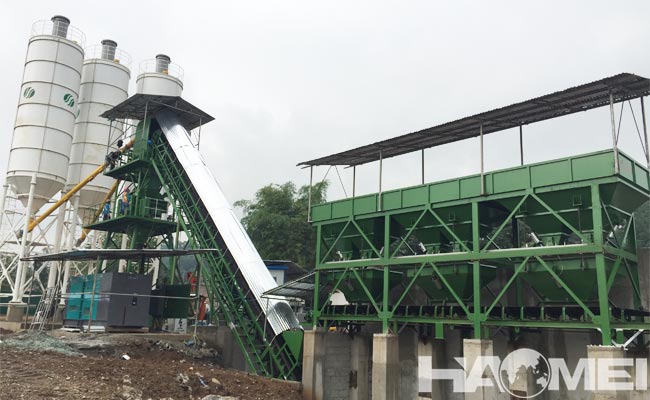Categories
- Case & News (50)
- Blog (564)
The concrete batch plant production rate is a key indicator to measure its production capacity. It is divided into theoretical productivity and actual productivity. There are obvious differences in the definition, calculation method and influencing factors between the two.

I. Theoretical productivity
Theoretical productivity refers to the maximum volume of concrete that can be produced per unit time (usually 1 hour) by a concrete mixing plant under ideal working conditions (no equipment failure, sufficient raw materials, and continuous operation). It is the designed rated capacity of the equipment.
1. Value
The theoretical productivity of HZS series concrete batching plant is 25-240m3/h,
2. Influencing factors (theoretical level)
– Host capacity: The larger the capacity, the higher the single batch output;
– Cycle time: The shorter the designed cycle time, the higher the theoretical productivity;
– Equipment configuration: such as whether the efficiency of the batching system and the conveying system matches the host.
II. Actual productivity
Actual productivity refers to the actual concrete output per unit time of a mixing plant in an actual production environment, taking into account factors such as equipment loss, operating efficiency, raw material supply, and management scheduling, which is usually lower than the theoretical value.
1. Calculation formula
The actual productivity needs to be multiplied by various efficiency coefficients based on the theoretical productivity: Actual=Theoretical×K1×K2×K3×K4
– K1: Equipment utilization coefficient (0.7~0.9), reflecting the downtime caused by equipment failure and maintenance;
– K2: Time utilization coefficient (0.6~0.8), considering non-production time (such as shift change, waiting for raw materials);
– K3: Operation efficiency coefficient (0.8~0.9), related to the operator’s proficiency and process connection;
– K4: Raw material influence coefficient (0.7~0.9), affected by aggregate moisture content, powder conveying stability, etc.
2. Core influencing factors (in actual production)
Equipment factors
– Equipment aging leads to extended mixing time;
– Insufficient precision of the batching system, repeated weighing is required;
– Conveying equipment failure (such as belt deviation, screw machine blockage).
Raw material factors
– Fluctuation of aggregate moisture content affects the time of mix ratio adjustment;
– Untimely supply of powder (cement, fly ash) leads to downtime waiting;
– Unreasonable aggregate grading affects mixing uniformity.
Operation and management
– Operators are not proficient in parameter settings (such as mixing time, feeding sequence);
– Chaotic production plan, frequent switching of concrete strength grades (such as alternating production of C30 and C50), and the need to clean the main machine.
External environment
– Insufficient dispatch of transport vehicles leads to backlog of finished materials and the main machine cannot unload;
– Weather influence (such as heavy rain causing sudden changes in aggregate moisture content, or low temperature affecting concrete fluidity).
III. Optimization measures to improve actual productivity
– Equipment maintenance:
Regularly calibrate the batching scale (error ≤2%), clean the concrete residue bonded in the mixing main unit, and shorten the cycle time;
Configure spare powder tanks and aggregate silos to reduce the risk of raw material supply interruption.
– Operation standardization:
Train operators to master the mixing parameters of different mix ratios (such as C30 concrete mixing time ≥60 seconds, C50 ≥90 seconds);
Use automated control systems (such as ERP production management system) to reduce human error.
– Management optimization:
Plan production tasks in advance, concentrate on the production of concrete of the same strength grade, and reduce the number of times the main machine is cleaned;
Coordinate with the transport fleet to ensure that the finished materials are “shipped as soon as they are delivered” to avoid the main machine waiting for unloading.
– Raw material control:
Build an aggregate rain shelter, monitor the moisture content in real time and automatically adjust the mix ratio;
Give priority to bagged powder (reduce the waiting time of bulk trucks), or configure double powder delivery pipelines.
Productivity reference of common mixing station models in the industry
| Model | Theoretical productivity (m³/h) | Actual productivity (m³/h) | Applicable scenarios |
| HZS60 | 60 | 30~45 | Small construction sites, township projects |
| HZS120 | 120 | 60~90 | Medium-sized commercial mixing stations, municipal projects |
| HZS180 | 180 | 90~140 | Large commercial mixing stations, highway projects |
| HZS240 | 240 | 120~180 | Super large projects (such as high-speed railways and airports) |
The theoretical concrete batch plant production rate is the design capacity of the equipment, while the actual productivity is subject to multiple realistic factors. In engineering applications, it is necessary to plan production capacity based on actual productivity, and narrow the gap with the theoretical value through equipment maintenance, process optimization and other means to maximize production capacity.